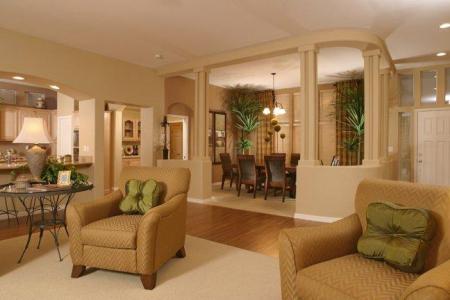
There are many positive aspects to furnishing a home for sale. Here is a quote from the New York Times:
“The scale varies, but the purpose is the same, to sell the house.”
The same home without the furniture or décor would look okay,
but with the interior furnishings, looks dramatic and says ‘quality!’
A model home is a benefit to customers and sellers alike! Why? Because as many as 90% of the population can’t imagine how a room looks until they see it furnished and decorated. Home shoppers want to ‘see,’ so staging a home is good for sellers and buyers alike.
There is ample and over whelming evidence as to the advantages of furnishing empty houses. Real estate companies are among the first to advocate staging/modeling. Here is a partial list of their reasons:
Home appeals to more people
Gives a positive first impression
Highlights special features in a home
Home appears larger – not smaller – once properly furnished. That means, don’t overdue the decor or furnishings.
Enhanced professional image for realtor.
Staging or modeling takes a home from ‘good’ to “great!”
If you own a manufactured home and are thinking about selling it, keep in mind that your home will sell faster and for more money if you’ve cleaned it, have all the items looking good and in proper working order.
Let’s take some time to shed a light on the terminology for furnishing otherwise empty houses.
Furnishings and proper lighting creates points of engagement and appeal.
Accessories draw and hold a home shoppers interest. It sets your
company apart from the ‘rest of the pack.’
Staging. Staging was originally developed to give individual home owners and real estate Company’s access to the “LOOK” of a well designed and organized model home. It is most generally used on a short term basis, though not always. Staging may involve renting the furniture, and as such, one is subject to the furniture supplied by the staging company. The selections can be limited, but the price is reasonable. A discount is usually given for contracts longer than 12 months.
Furniture and décor transform a house into a home your prospects can picture living in.
Staging lacks flexibility and customization…its weakest area is for accessories (more about this later) .
On a personal note, I have done staging (renting décor and furnishings) and found that it worked well for that customer. In those cases, the client’s needs were not as specific, the time frame for usage was shorter and it hit the customer profile.
Model Homes. Providing a model, in the traditional sense, allows for more customization and flexibility. The furniture and all other items are purchased rather than rented, this being an advantage for some companies who are willing to invest in model home furnishings.
Light, color, furniture and décor can make a home ‘pop’ with appeal.
By far the main advantage a model home has over a staged home is this flexibility in design. Models also have more specificity because they are geared to the enhancement of only the house in which all purchased items will be installed. There are few limitations in selection. The décor is developed to engage the customer and bring attention the architectural features and benefits of the specific house.
This flexible aspect allows model homes to use more purchasing power where needed.
Here is an example of using the monies where needed:
Rather than using an aqua leather sofa, the same style sofa covered in aqua faux suede is much less expensive. The effect is the same, but the savings can pay for most of the needed accessories which will really WOW the room.
I spend more on accessories than on any other part of the budget.
This is a good opportunity to advise using a professional designer/decorator for your project. They have the training and the knowledge needed to accomplish everything mentioned here.
When furnishing a model, or staging it, the expertise of a qualified person can provide the latest in marketing trends and materials selections. They do all this without being subject to personal preferences or tastes. Few spouses or others who some may try to use instead of a trained professional can do this.
There are photos shown here of model homes done by Design Concept and all are in manufactured homes. I think you will agree that interior marketing makes a real statement.
“The problem may not be the house itself, it may be the impression it makes—or the lack thereof. In the case of an empty house, a buyer may not be able to picture where his own possessions would fit in.” – BusinessWeek.com # #

 manufacturedhomelivingnews.com Manufactured Home Living News
manufacturedhomelivingnews.com Manufactured Home Living News



































